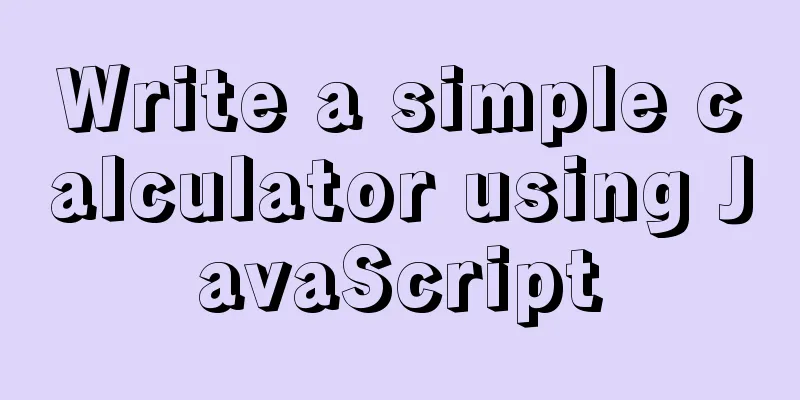Write a simple calculator using JavaScript

|
The effect is as follows:
Reference Program:
<!DOCTYPE html>
<html lang="en">
<head>
<meta charset="UTF-8">
<meta http-equiv="X-UA-Compatible" content="IE=edge">
<meta name="viewport" content="width=device-width, initial-scale=1.0">
<title>Analog Calculator</title>
<style>
button {
width: 39px;
height: 30px;
background-color: rgb(102, 240, 102);
}
button:hover {
background-color: black;
color: rgb(255, 249, 237);
}
button:active {
background-color: rgb(79, 72, 72);
color: white;
}
table{
background: rgb(192, 248, 109);
}
</style>
</head>
<body>
<div>
<table border="1px">
<tr style="text-align: center;">
<td colspan="4">
<input type="text" id="result" >
</td>
</tr>
<tr>
<td><button id="le" onclick="getChar('(')">(</button></td>
<td><button id="rg" onclick="getChar(')')">)</button></td>
<td><button id="baifen" onclick="getChar('%')">%</button></td>
<td><button id="C" onclick="clear1()">C</button></td>
</tr>
<tr>
<td><button id="seven" onclick="getChar('7')">7</button></td>
<td><button id="eight" onclick="getChar('8')">8</button></td>
<td><button id="nine" onclick="getChar('9')">9</button></td>
<td><button id="divi" onclick="getChar('/')">/</button></td>
</tr>
<tr>
<td><button id="four" onclick="getChar('4')">4</button></td>
<td><button id="five" onclick="getChar('5')">5</button></td>
<td><button id="six" onclick="getChar('6')">6</button></td>
<td><button id="mul" onclick="getChar('*')">*</button></td>
</tr>
<tr>
<td><button id="one" onclick="getChar('1')">1</button></td>
<td><button id="two" onclick="getChar('2')">2</button></td>
<td><button id="three" onclick="getChar('3')">3</button></td>
<td><button id="dec" onclick="getChar('-')">-</button></td>
</tr>
<tr>
<td><button id="zero" onclick="getChar('0')">0</button></td>
<td><button id="point" onclick="getChar('.')">.</button></td>
<td><button id="=" onclick="getResult()">=</button></td>
<td><button id="add" onclick="getChar('+')">+</button></td>
</tr>
</table>
</div>
</body>
<script>
// Click the button to return the button value function getChar(btnid) {
var btns = document.getElementsByTagName("button")
switch (btnid) {
case '+':
setNum('+')
break;
case '.':
setNum('.')
break;
case '=':
setNum('=')
break;
case '0':
setNum('0')
break;
case '1':
setNum('1')
break;
case '2':
setNum('2')
break;
case '3':
setNum('3')
break;
case '-':
setNum('-')
break;
case '4':
setNum('4')
break;
case '5':
setNum('5')
break;
case '6':
setNum('6')
break;
case '7':
setNum('7')
break;
case '8':
setNum('8')
break;
case '9':
setNum('9')
break;
case '/':
setNum('/')
break;
case '*':
setNum('*')
break;
case '(':
setNum('(')
break;
case ')':
setNum(')')
break;
case '%':
setNum('%')
break;
default:
break;
}
}
// Clear the display function clear1() {
document.getElementById("result").value = ""
}
// Display the value on the display function setNum(charCode) {
var origin = document.getElementById('result');
origin.value += charCode;
origin.innerText = origin.value;
}
//Calculation result function getResult(){
var res = eval(document.getElementById("result").value);
// Append '='
setNum('=');
// Append result setNum(res)
}
</script>
</html>
For example:
var num = eval('3+3')
The result of the operation is Eval function usage: Syntax: Return value:
This is the end of this article about using You may also be interested in:
|
Recommend
How to track users with JS
Table of contents 1. Synchronous AJAX 2. Asynchro...
WeChat applet wxs date and time processing implementation example
Table of contents 1. Timestamp to date 2. Convert...
MySQL 5.7.20 compressed version download and installation simple tutorial
1. Download address: http://dev.mysql.com/downloa...
Example of how to embed H5 in WeChat applet webView
Preface WeChat Mini Programs provide new open cap...
Example of creating a virtual host based on Apache port
apache: create virtual host based on port Take cr...
Mysql uses the kill command to solve the deadlock problem (kill a certain SQL statement being executed)
When using MySQL to run certain statements, a dea...
How to count down the date using bash
Need to know how many days there are before an im...
Summary of commonly used operators and functions in MySQL
Let’s build the data table first. use test; creat...
Winows Server 2019 Activation Code & Volume License Edition KMS Installation Key GVLK
I am planning to organize the company's inter...
Details on macrotasks and microtasks in JavaScript
Table of contents 1. What are microtasks? 2. What...
Getting Started with Website Building for Beginners - The Conditions and Tools Needed to Build a Website
Today, I will answer these newbie questions: Build...
Teach you how to install mysql database on Mac
Download MySQL for Mac: https://downloads.mysql.c...
Demonstration of building ElasticSearch middleware and common interfaces under centos7 in Linux system
1. Introduction to Middleware 1. Basic concepts E...
How to install nginx under Linux
Nginx is developed in C language and is recommend...
How to debug loader plugin in webpack project
Recently, when I was learning how to use webpack,...










